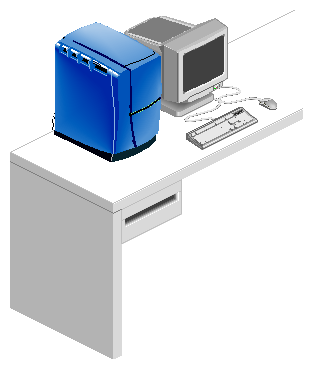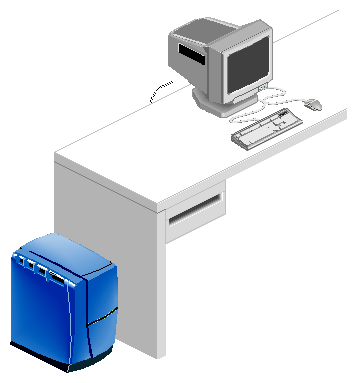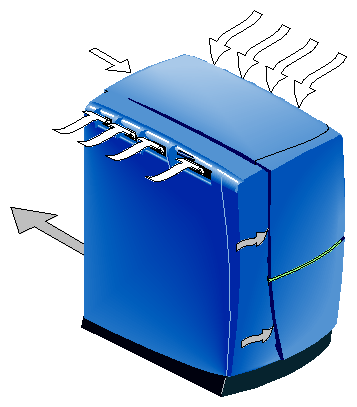The Octane system is a powerful, graphics-intensive workstation, designed for the most complex of graphics tasks.
Octane systems are available with either single or dual MIPS processors.
Silicon Graphics Octane systems are designed to be located either on a desktop or beside a desk. Figure 4-1 shows an Octane system in a typical desktop configuration, and Figure 4-2 shows an Octane system in a typical deskside configuration.
Figure 4-3 shows the airflow path in Octane systems. The white arrows show the air intake areas on the top left, top right, top rear, and the front of the system. The darker arrow shows the air exhaust area at the rear of the system. Be sure that the location selected allows free flow of air to and from the areas shown.
Octane systems are designed for use in typical office computing environments: The air temperature should not fluctuate dramatically, air should circulate freely, and the location should be relatively dust free.
For information about selecting a physical location for an Octane system, see “Selecting a Location for an Octane System”.
Table 4-1 lists the physical specifications of the Octane chassis.
Table 4-1. Octane Chassis Physical Specifications
Dimensions |
|
|
Installed: | length | 16.2” (41.2 cm) |
In Packaging[a]: | length | 29.6” (75.2 cm) |
Weight: | installed | 72 lbs (32.7 kg) |
Air Temperature: | operating | 50° to 95° F (10° to 35° C) |
Thermal Gradient: | operating | 18° F (10° C) per hour (maximum) |
Altitude: | operating | 10,000 ft (3,048 m) MSL (maximum) |
Relative Humidity: | operating | 10-80% (non-condensing) |
Vibration: | maximum | 0.02”, 5-19Hz; 0.35 G, 19-500 Hz |
[a] It is important that Octane systems be shipped only in their complete packaging, including the pallet. | ||
Table 4-2 provides power consumption and required cooling capacity information for the Octane system. For formulas, descriptions, and general information about power and cooling, refer to “ Electrical Requirements” in Chapter 2 and “ Thermal Requirements” in Chapter 2.
| Caution: The power and cooling figures listed in Table 4-2 are maximums. Actual power and cooling requirements will vary, depending on configuration and load. Ask your SGI representative about particular configurations. |
Table 4-2. Octane Power and Cooling Specifications
Volts: |
| 100-120 volts AC, 1-phase |
Watts (from the wall): | maximum | 850 watts (see “Caution,” above) |
Power Factor: | minimum | 0.98 |
Total Harmonic Dist.: | at 120 volts | 5% maximum |
Inrush Current: | peak | 60 amps |
Frequency: |
| 47-63 Hz |
Cooling Requirements: | maximum | 2,899 Btu/hr (0.24-ton AC load) (see
“Caution,” above) |
Airflow Volume: | maximum | 60 cfm (0.028 m3/s) |
See Appendix B, “Site Power and Power Cables”, for information about Octane chassis site-wiring and power cables.
An Octane system typically has a one or more monitors, a keyboard, and a mouse. For more information, see “Monitors” in Appendix A, “Keyboards” in Appendix A, and “Mice” in Appendix A.
An Octane system may also have one or more external SCSI devices attached to it. For small SCSI devices, see “External SCSI Devices” in Appendix A. Also see information about Origin Vault systems in “Origin Vault Site Requirements” in Chapter 5.
Besides power cables and external peripherals (mentioned above), Octane systems are typically wired to network cables, serial and parallel devices, and so on. For details of the ports found on an Octane workstation, see the Octane Workstation Owner's Guide.
See Appendix B, “Site Power and Power Cables”, for information about Octane chassis site-wiring and power cables.


